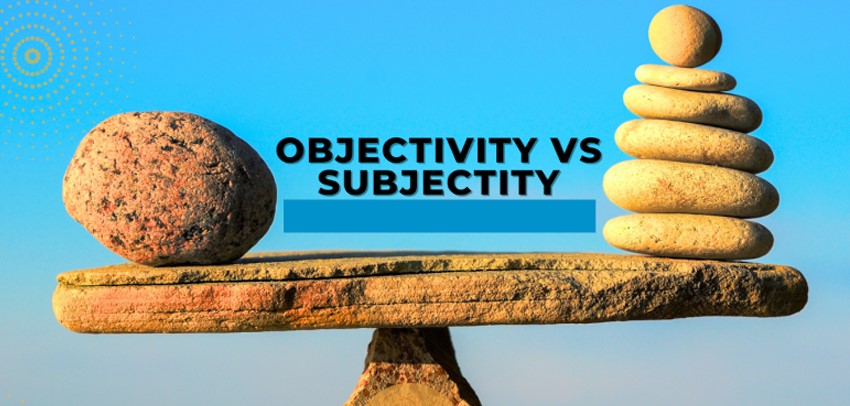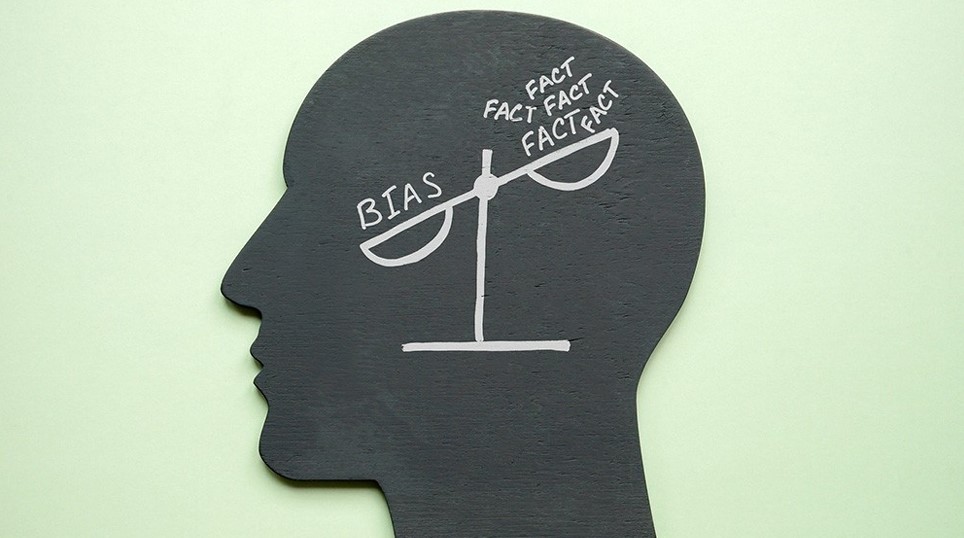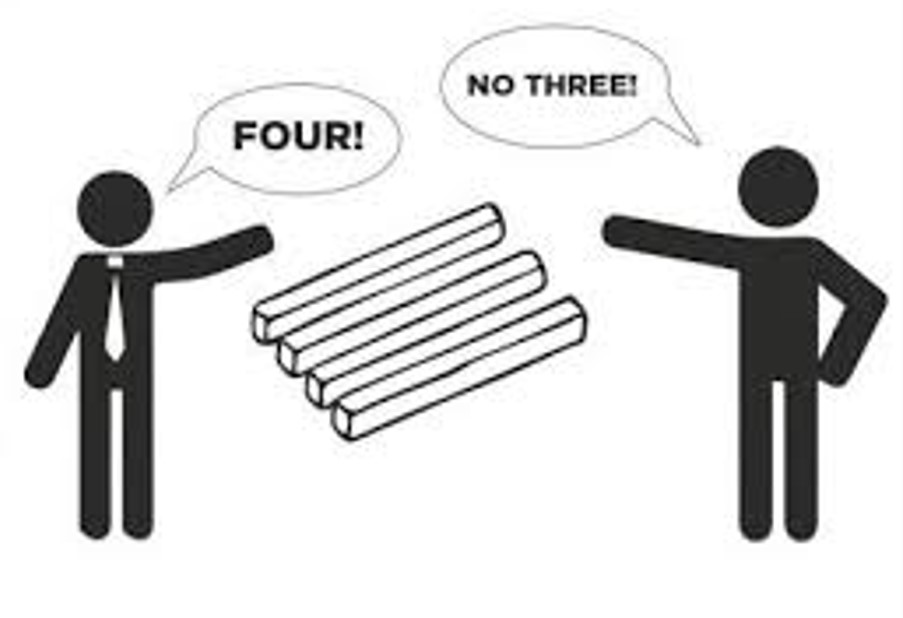Computational Thinking
Objectivity and Computational thinking

Visit Paul's websites:
From Computing to Computational Thinking (computize.org)
Becoming a Computational Thinker: Success in the Digital Age (computize.org/CTer)

We all know that being objective is good. In fact most people are often confident in their own objectivity. However, such confidence can be severely challenged in the information age, with an overload of data coming our way from all directions. How do we tell the lies, half truths, and propaganda from facts? As responsible netizens, how do we stop rumors, sensationalism and get the facts out?
Actually, at a more basic level, what is objectivity anyway? How is it related to subjectivity? Why is objectivity a virtue? If so, how do we make ourselves more objective? Here we will discuss these and other questions.
This article is part of our ongoing CT blog published in aroundKent (aroundkent.net), an online magazine. Other enjoyable and engaging CT articles can also be found in the author’s book Becoming A Computational Thinker: Success in the Digital Age. For more information, please see the website computize.org/CTer.
What Is Objectivity?
Objectivity means seeing things as they are, not as we wish them to be. It is the practice of putting aside personal bias, emotion and prejudice to discover and understand facts. It is an intentional “practice” that requires attention and effort.
It does not mean stripping away humanity; it means giving reality a chance to speak for itself.
A judge is expected to be objective in weighing evidence, not in siding with friends. Ancient Chinese historian Sima Qian (司馬遷) insisted on

truth in his records, even when it angered emperors. Today his works remain invaluable because of that commitment to objectivity.
What Constitutes Objectivity?
Objectivity is not just the absence of subjectivity. It is the presence of disciplined methods for reducing bias and aligning views with reality.

- Not subjective is not equal to objective—A person may avoid inserting personal feelings but still fail to be objective if they use poor data, flawed reasoning, or incomplete information. For example, someone argues the Earth is flat by advancing the seemingly common-sense point “if it were round, then people on the other side would have fallen off!” That is neither subjective nor objective–it is simply uninformed. In the language of logic: absence of subjectivity is a necessary but not sufficient condition of objectivity.
- Objectivity requires positive qualities—Evidence-based reasoning (grounding views in verifiable facts), consistency (applying the same standards in similar cases), transparency (making methods and assumptions clear so others can check them), and self-correction (willingness to change when confronted with better evidence) are some central qualities. In this sense, objectivity is an active achievement, not a inherent quality.
- It’s not always either/or—In practice, few views are purely objective or purely subjective. Most lie on a spectrum. A scientist reporting lab measurements is closer to the objective end. A poet describing the feeling of autumn is closer to the subjective end. Many real-world judgments—like choosing a career, developing a hobby, or making policy— mix both. Objective data can inform consideration, analysis, deliberation, and subjectivity often help make the final decision.
- Why the distinction matters—Subjectivity matters for meaning, culture, and personal fulfillment. Objectivity matters for fairness, accuracy, and shared truth. The danger comes when we confuse the two— mistaking personal preference for fact, or dismissing lived experience as irrelevant data. Thus, not being subjective is not enough. Objectivity requires methods that align thought with reality. And not being objective does not always mean being subjective, it can also mean being careless, uninformed, or undecided.
Why Objectivity Matters
Objectivity is essential because decisions ripple outward—affecting individuals, communities, and entire societies.
- Science: Galileo’s telescope showed moons orbiting Jupiter, overturning Earth-centered beliefs. His objectivity advanced science despite resistance.
- Medicine: Clinical trials must maintain strict objectivity of all involved to ensure the validity of outcomes. In triple-blind trials, they include patients, clinicians/doctors, and data analysts.
- Everyday life: Buying a car requires more than liking the color or how the doors close—you need to consider functionality, safety, energy efficiency and cost.
Objectivity Is Not Easy
Human brains are wired for survival, social belonging, and quick decision making, not particularly for cold logical reasoning or neutrality. Let’s look at some factors that can lead us astray.

- Knee-jerk reaction: A quick impulsive reaction and unthinking response often driven by deeply ingrained survival instincts.
- Conformity bias: We tend to adjust our views to align with the majority view with little reasoning or skepticism.
- Confirmation bias: We prefer evidence that supports what we already believe.
- Emotion over fact: Like/dislike, fear, greed, timidness/boldness, optimism, pessimism, wishful thinking, overlooking details, blind trust, laziness, impatience, you name it.
- Cultural bias: “Saving face”, following tradition or superstition can override factual evidence.

These are just some of the many biases. We can also find many cases in daily life where people jump to conclusions or accept broad claims as if they were objective truths. On closer inspection, many of these beliefs are incomplete, misleading, or simply wrong:
- “Sweets cause diabetes”⊗ —The reality is more complicated. Sugar alone does not directly cause diabetes; it is long-term patterns of diet, exercise, weight, and genetics that increase risk. The slogan is catchy but not objective.
- “The more exercise, the healthier”⊗ —Exercise is beneficial, but too much can damage joints, strain the heart, or lead to burnout. Objective research shows that moderation is key—more is not always better.
- “Natural products are always safe”⊗ —Poison ivy is natural, but it is not safe. Many people conflate “natural” with “harmless” without evidence.
- “If something is expensive, it must be good”⊗ —Price is influenced by marketing, branding, and scarcity—not only quality. Objectively, many lower-cost items outperform luxury alternatives.
- “Personal experience is proof”⊗ —Someone might say, “My grandfather smoked and lived to 90, so smoking isn’t harmful.” But anecdotal evidence doesn’t replace objective population-level data.
Challenges in the Information Age
In the information age, our challenge is greater than ever. Social media feeds are filled with rumors, half-truths, and outright lies—amplified by algorithms that reward clicks and outrage more than accuracy.

- A rumor about a new food trend may spread faster than any scientific study.
- Half-truths about politics, health, or climate circulate widely because they sound simple and appealing.
- Deliberate lies—so-called “fake news”—can polarize entire societies. In this environment, objectivity is no longer optional. Netizens must actively cross-check sources, resist emotional clickbait, and seek verifiable facts.
And here is where generative AI can help. Just as we once used dictionaries or encyclopedias to double-check claims, we can now ask AI systems to:
- Summarize multiple news reports to reveal differences in framing.
- Highlight whether a statement has supporting evidence or whether it is rumor-level.
- Point out when a claim contradicts established facts (e.g., public health data, scientific consensus).
AI doesn’t decide truth for us—but it gives us a second lens, helping us cross-check quickly and avoid falling for what merely sounds true. Combined with Computational Thinking (CT), it can keep us anchored in reality while navigating the storm of online information.
CT: A Mental Tool for Objectivity
Computational Thinking lets us apply key methods in digital computing to handle all kinds of problems including those in our daily lives. Computational thinkers do not tolerate lack of objectivity. Hence, CT is a mindset that helps us approach problems in a structured, disciplined way. Like exercise building strength, CT can build objectivity mental muscles. Here are some mental tools provided by CT.
- Decomposition: Break a complex question into smaller parts and examine each part closely.
- Abstraction: Focus on what matters, filter out noise.
- Algorithms and procedures: Specify a sequence of solution steps. Apply consistent rules and follow logical deductions.
- Evaluation: Measure results against set criteria.
- Mental sharpness: Pay attention to details, ask what-if questions, and pre-plan for possible failures.
- Accepting new ideas: Become comfortable with binary numbers, the basis of digital computers, where the symbol 10 represents the number two.
- Focus on problem areas: Pay attention to efficiency of systems, their interfaces and interactions.
Use these to detect and reduce your natural biases.
Use AI As a Mirror
Powerful generative AI systems are at the forefront of technology and offer an instructive mirror. They are not “perfectly objective,” but their methods can demonstrate what true objectivity looks like in practice. AI doesn’t replace human wisdom—it shows us our blind spots.
1. AI uses objective methods.
- Data-driven analysis: Looks at inputs, not moods.
- Consistency: Same input gets same output, unlike humans swayed by fatigue, impatience, or bias.
- Scale: Processes massive data that no person could. Example: AI in radiology can spot tumors earlier than doctors who may be tired or distracted.
2. AI and humans use the same foundations. Both rely on past data and accumulated facts.
- A carpenter knows good wood grain from experience.
- An AI system identifies the same from thousands of sample images.
The difference? AI sticks to procedure, while we may let emotions, social pressures, or personal perspective override our experience.

3. AI can help us practice objectivity.
- Medicine: AI flags symptoms a doctor may dismiss.
- Journalism: AI highlights loaded words reporters might unconsciously use.
- Personal: AI crime maps may contradict someone’s “gut feeling” about their neighborhood.
4. AI has limits.
- Bias in, Bias out. AI systems are trained by human engineers and learn from human data, so they can absorb human errors and prejudice.
- Amazon’s hiring AI down-ranked women’s resumes.
- Early facial recognition misidentified darker skin tones.
So AI is not inherently objective—it inherits biases and errors in whatever data we give it.
Why Objectivity Is a Virtue: An Objective Argument
Why claim that objectivity is desirable at all? Isn’t subjectivity part of being human? To answer this fairly, we need to consider consequences of making decisions with/without objectivity.
Predictability and Trust
Without objectivity, decisions shift with moods, favoritism, or pressure. That creates uncertainty and erodes trust. With objectivity, rules and criteria apply consistently, so others can predict outcomes. Societies, courts, and businesses function better when people trust that fairness outweighs personal bias.
Accuracy and Survival
Subjective judgment can distort reality (e.g., “the Earth is flat,” “disease is caused by bad spirits.” Objective reasoning—guided by evidence—has led to medicine, engineering, and technology that keep us alive and thriving. Objectivity has survival value.
Fairness and Justice
If leaders, judges, or employers act on favoritism, injustice follows. History is filled with corruption and nepotism where objectivity was absent. Objective decision-making (e.g., merit-based exams, blind auditions in music) reduces unfair advantage and expands opportunity.
Correcting Bias Over Time
Human groups often believe falsehoods for centuries. Objective methods (like the scientific method, peer review, statistical analysis) provide a way to self-correct. Without objectivity, errors compound. With it, knowledge steadily improves.
Thus, from an outcome-based perspective, objectivity proves itself as a virtue: it produces more accurate knowledge, more fairness in society, and more trust in institutions.
Lack of Objectivity Can Lead to Failures
History is filled with moments where bias, stubbornness, or subjective comfort led to disaster.
- War: During the Vietnam War, U.S. commanders measured success by “body counts.” This seemed objective but ignored context—numbers of casualties didn’t mean the war was being won. The obsession with one flawed metric led to years of misjudgment.
- Business: Kodak famously ignored the rise of digital photography. Executives clung to their subjective faith in film sales instead of listening to objective market data. The result: Chapter 11 bankruptcy in 2012. Xerox failed to recognize the true value of its own revolutionary GUI (Graphical User Interface) invention. Apple took the technology and launched the PC revolution.
- Finance: The 2008 stock market crash was fueled by bankers ignoring objective risk models in favor of short-term greed.
- Public health: Leaders downplaying smoking dangers in the mid-20th century led to millions of preventable deaths.
In each case, objective evidence existed. The failure was in ignoring it.
Objectivity and Human Nature
From personal conduct to social systems, objectivity must coexist with humanity. In person-to-person interactions, blunt truth without empathy can damage trust. A wise communicator practices compassionate objectivity— stating facts with timing, tone, and respect. Recognizing human imperfection is itself part of being objective. People are emotional and biased; pretending otherwise is unrealistic. Objectivity therefore requires patience toward others and humility toward oneself.
Societies also design systems to support objectivity: encouraging and training kids for independent thinking in schools, peer review, ethical codes, honors, and awards that reward fair and evidence-based behavior. These structures acknowledge that doing the right thing cannot rely on moral strength alone.
Yet incentives can corrupt if they become goals instead of means. When people chase recognition rather than truth, objectivity erodes. Thus, the ideal is balance: empathy in interactions, integrity in systems. Objectivity, when humanized, becomes a social art—individuals respect truth; institutions reward it; both evolve toward fairness.
Objectivity DOs and DON’Ts
Here are some rules and reminders that can make it easy for us to form a habit of being objective.
DOs
- Pause before reacting. Ask: "What do I know versus how do I feel?"
- Seek multiple sources. One data point or viewpoint is rarely enough.
- Use structured methods. Break problems into parts, apply consistent rules, check against criteria, pay attention to details and contexts, verify logic and reasoning.
- Embrace evidence and views that challenges you. Discomfort often signals a chance to examine more clearly.
- Admit uncertainty. Acknowledge when you lack enough data or face unpredictability—objectivity includes knowing your limits.
- Use AI tools for cross-checking. Ask it to compare sources, flag contradictions, or summarize balanced perspectives.
DON’Ts
- Don’t cherry-pick evidence. Ignoring inconvenient facts is the enemy of objectivity.
- Don’t confuse feelings with facts. Emotions are important, but they are not data. So, avoid expressions like “I know ...”, “I thought so.” or “You are right.” An objective discussion is not about you or me.
- Don’t rely on tradition or authority alone. “That’s how it’s always been” is not proof.
- Don’t shift standards midstream. Apply the same measures consistently, even if the outcome is uncomfortable.
- Don’t assume AI (or humans) are infallible. Always check for hidden bias in data and decisions. Discuss issues with others, especially disinterested individuals.
Conclusion
Objectivity is not easy or automatic. But it is achievable with tools and discipline. To conduct an objective discussion, consider the golden rule: “leave people out and facts in.” This way, we can maintain our focus and not get distracted.
The information age brings challenges and solutions. Computational Thinking gives us the mindset: break down problems, focus on what matters, apply fair rules. AI systems give us the toolset: consistency, scale, and a mirror to our blind spots. Together, CT and AI make objectivity not just an abstract ideal, but a practical habit of mind.
If we pay attention to being objective and keep on learning and improving our way of thinking, we can make better decisions in science, business, governance, and everyday life. Not to mention we can see through scams easily. The point is simple: reality rewards those who face it objectively.
ABOUT PAUL
A Ph.D. and faculty member from MIT, Paul Wang (王 士 弘) became a Computer Science professor (Kent State University) in 1981, and served as a Director at the Institute for Computational Mathematics at Kent from 1986 to 2011. He retired in 2012 and is now professor emeritus at Kent State University.
Paul is a leading expert in Symbolic and Algebraic Computation (SAC). He has conducted over forty research projects funded by government and industry, authored many well-regarded Computer Science textbooks, most also translated into foreign languages, and released many software tools. He received the Ohio Governor's Award for University Faculty Entrepreneurship (2001). Paul supervised 14 Ph.D. and over 26 Master-degree students.
His Ph.D. dissertation, advised by Joel Moses, was on Evaluation of Definite Integrals by Symbolic Manipulation. Paul's main research interests include Symbolic and Algebraic Computation (SAC), polynomial factoring and GCD algorithms, automatic code generation, Internet Accessible Mathematical Computation (IAMC), enabling technologies for and classroom delivery of Web-based Mathematics Education (WME), as well as parallel and distributed SAC. Paul has made significant contributions to many parts of the MAXIMA computer algebra system. See these online demos for an experience with MAXIMA.
Paul continues to work jointly with others nationally and internationally in computer science teaching and research, write textbooks, IT consult as sofpower.com, and manage his Web development business webtong.com

.jpg)
.jpeg)




